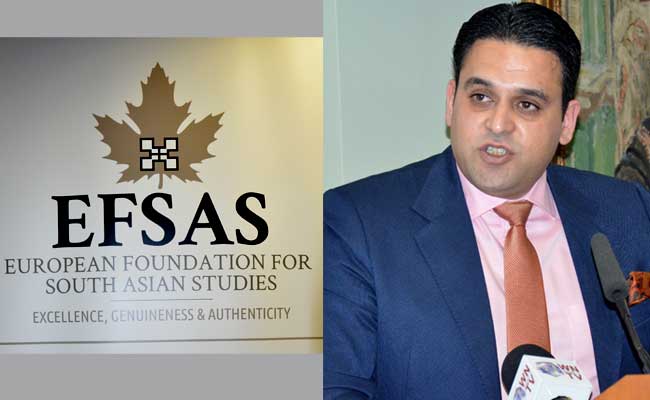CPEC, Gilgit Baltistan and Jammu & Kashmir in Legal Perspective

Speech of Junaid Qureshi, Director EFSAS. 15th of December 2017.
I would like to emphasize that I am not averse the friendship of China and Pakistan and I sincerely hope that it turns out to be, as both countries call it, “Higher than the mountains, deeper than the oceans and sweeter than honey”.
As I have been asked to discuss the implications of China’s presence in Gilgit Baltistan, and thus in the State of Jammu & Kashmir along with the construction of the China Pakistan Economic Corridor and its effects on the future of the wider issue of Jammu & Kashmir, I will mainly examine the construction of this corridor from a purely legal perspective. This will be a challenge as historical sensitivities, legalities and politics are very much interrelated with regard to Gilgit Baltistan, and in turn, the State of Jammu & Kashmir. Therefore, I request you to allow me some leverage to overlap.
Historically, several independent small princely states together made up Gilgit Baltistan before it was formally incorporated and absorbed into the Princely State of Jammu & Kashmir by the Royal Dogra Dynasty in 1846. Like other Princely States, Jammu & Kashmir found itself neither part of India nor part of Pakistan when today’s modern sovereign States, the Republic of India and the Islamic Republic of Pakistan were carved out of United India in 1947.
During the Raj, the status of the 560 plus Princely States, was tantamount to that of direct colonies, but these were technically and formally not part of British India. Its rulers were allowed to govern their States independently, and by treaty, the British only controlled Foreign Policy and International Relations. The State of Jammu and Kashmir was ruled by the Dogra Maharaja, Hari Singh, under the paramountcy of British India when during Partition the British Viceroy offered Princely States the right to accede either to India or Pakistan by executing an Instrument of Accession signed by the Ruler and accepted by the Governor General of the Dominion. The decision to accede to either Dominions was an exclusive right of the ruler.
The State of Jammu and Kashmir, which was contiguous to both India, and newly formed Pakistan, initially decided to remain Independent. It offered to sign Standstill Agreements with both the Dominions. Pakistan signed the Standstill Agreement while India asked for further discussions on its contents.
Pakistan violated the signed treaty on the 22nd of October 1947 when it invaded Kashmir and Jammu provinces from the north comprising tribesmen from Pakistan’s North West Frontier Province and regulars from its Army. In July 1948, the Pakistani Foreign Minister admitted complicity which was later reconfirmed by General Akbar Khan, then Brigadier, in his book, ‘Raiders in Kashmir’, who led the attack.
On 26th of October 1947, the Maharaja of Jammu & Kashmir made an appeal to India to come to its rescue, to which India agreed, requesting the Maharaja to sign an Instrument of Accession which would serve as the legal basis for India’s intervention. This Instrument of Accession is a legal document, executed by Maharaja Hari Singh, thereby agreeing to accede to the Union of India and in essence changing Jammu & Kashmir legal status for the first time since the Dogra’s took over. Flowing from this legality, the Instrument of Accession also obligates the Union of India to clear the State of Jammu & Kashmir from foreign forces, in this case, the Pakistani forces.
Consequently to the signing of the Instrument of Accession by the Maharaja, the first war was fought between India and Pakistan over the Princely State of Jammu and Kashmir from 1947 to 1948. On the night of the 1st of January 1948, Prime Minster of India, Jawahar Lal Nehru called his forces and a formal cease-fire was declared as he approached the UN Security Council to lodge a complaint, pursuant to Article 35 under the UN Charter, invoking the Security Council’s dispute resolution capacity. By the end of the war, India was able to clear the regions of Kashmir Valley, Jammu and Ladakh and the other regions including Pakistan Administered Jammu & Kashmir and Gilgit Baltistan comprising of around 34.000 square miles came under Pakistani Administration, making the division of the erstwhile Princely State of Jammu & Kashmir, a reality.
Despite claims made by Pakistan by virtue of having Gilgit Baltistan under its administration or claims made by India based on the Instrument of Accession, as the matter of Jammu & Kashmir went to the United Nations in 1948, so did, inevitably, the matter of Gilgit Baltistan, which meant that Gilgit Baltistan, and thus, in turn the State of Jammu & Kashmir, became disputed.
Based on the UN Resolutions, Pakistan agreed to withdraw its troops from Jammu & Kashmir State, yet failed to do so till date which meant that the United Nations Commission for India and Pakistan was unable to communicate to India ratification of implementation of the truce arrangements set forth in Parts I and II of the Commission’s resolution of 13th of August 1948 which stated that the withdrawal of Pakistani troops from the State of Jammu & Kashmir was the first step in implementing the other sub-sequential articles of the UN Resolutions. Because of non-compliance of the truce arrangements by Pakistan, the question of a Plebiscite fell through and was never revived at the UN level. The factual situation remains that these resolutions are not-enforceable by the UN and are based on choice between India and Pakistan, as these do not allow unlimited self-determination which means a choice without limitation. Had the resolutions been based on self-determination like East Timor, then under the UN Charter, the Secretary-General could have moved the case at UN level.
Now he cannot.
After 1965, India and Pakistan have almost exclusively dealt with the conflict bilaterally. Both countries agreed to put an end to the conflict and confrontation that had marred their relations, and resolve their differences by peaceful means through bilateral negotiations without any third-party intervention by signing the Simla agreement in 1972. To progressively restore and normalize relations between the two countries it was agreed that the UN designated ceasefire line would be converted to the de-facto border and be called the Line of Control and would not to be altered unilaterally irrespective of mutual differences or legal interpretations. The signing of the Simla agreement essentially made Jammu & Kashmir dispute a bilateral one, to be mutually resolved between the two countries and took it out of the purview of the United Nations or any other third party mediation. The issue of Jammu & Kashmir has been intricated from the very outset by first accepting UN Security Council as an intermediary, then by not complying to the suggested resolutions and afterwards by intermittently signing bilateral agreements and thereby infringing earlier agreements at UN level.
Coming back to the construction of the China Pakistan Economic Corridor, abbreviated as CPEC.
The origins of this new partnership between China and Pakistan can be traced back to the Border Agreement of 1963, signed between Chinese Foreign Minister Chen Yi and President Zulfikar Ali Bhutto of Pakistan, which re-established the border between China and Pakistan. Based on this agreement, more than 5000 square kilometres of Jammu & Kashmir, known as the Shaksgam Valley and part of the territory of Baltistan, was ceded by the Pakistani Government to China for the construction of the Karakoram Highway. At a cost of 50 billion dollar, today’s CPEC is an important pawn in the unfolding New Great Game and an extension of China’s ambitions of reconstructing the ancient Silk Road.
Part of this 3,000-kilometer long network of roads, railways and pipelines, will pass through Gilgit Baltistan, formerly and incorrectly known as the Northern Areas of Pakistan, which legally is an elemental part of the disputed territory of Jammu & Kashmir.
While administratively controlled by Pakistan since the First Kashmir War, Gilgit Baltistan has never been formally and legally integrated into the Pakistani State and does not participate in Pakistan’s constitutional political affairs as subsequent Pakistani administrations have argued that the Pakistani State cannot officially integrate Gilgit Baltistan into Pakistan in line with its claimed position that a referendum should be carried out across the whole of the region and any such step would prejudice its international obligations with regard to the Jammu & Kashmir conflict. Internationally, Pakistan has always insisted that the parts of Jammu & Kashmir it controls, are semi-autonomous, which of course is further debatable.
The Maharaja of Jammu and Kashmir had granted special provisions to the people of his Princely State, one of which was ‘the State Subject Rule’. The State Subject Rule protects the status of the indigenous people since the rule only allows the natives, referred to as State-Subjects to acquire permanent residence in the State. Pursuant to this rule, the natural resources of the State are the property of the indigenous people who have the right to utilize them without any outside interference. International Law or Bilateral Agreements between India and Pakistan do not have any bearing whatsoever on this Rule. The said State Subject Rule was abrogated in Gilgit-Baltistan in 1974 by the Government of Pakistan, which resulted in demographic changes in the territory and in 2009, the Gilgit Baltistan Empowerment and Self-Governance Order was passed by the Pakistani Cabinet. The order granted self-rule to the people of Gilgit Baltistan, by creating, among other things, an elected Gilgit Baltistan Legislative Assembly and Gilgit Baltistan Council. Yet, the indigenous people did not gain control over their natural resources and minerals as all decision-making powers in relation to forest, power, tourism and minerals are under the direct control of the this newly created Gilgit Baltistan Council, which is headed by the Prime Minister of Pakistan. Gilgit Baltistan, thus in 2009, gained a de-facto province-like status without constitutionally becoming part of Pakistan.
Notwithstanding legal and international constraints, it has become imperative from China’s perspective that Gilgit Baltistan has a political status within Pakistan. From Beijing’s point of view, a political status for Gilgit Baltistan would address the domestic concerns of the local people and externally Indian and American objections.
In this backdrop, a high level committee was formed in the beginning of 2017 by the Prime Minister of Pakistan, which recently made its recommendation to the Government to elevate the constitutional status of Gilgit Baltistan by absorbing it as an additional province of Pakistan, in a bid to provide legal cover to the multi-billion-dollar Chinese investment plan.
This step is in utter contradiction to Pakistan’s own Constitution and its Article 257, a provision related to the State of Jammu and Kashmir defining the relation between the State of Jammu & Kashmir and Pakistan. It states: “When, the people of the State of Jammu and Kashmir decide to accede to Pakistan, the relationship between Pakistan and the State shall be determined in accordance with the wishes of the people of that State”.
Any unilateral alteration, without that possible accession, has to be examined in the backdrop of this constitutional provision, which by definition makes the abrogation of the State Subject Rule in Gilgit Baltistan, the Gilgit Baltistan Empowerment and Self-Governance Order and the transformation of Gilgit Baltistan into a province of Pakistan, illegal.
Pakistan’s move to illegally annex Gilgit Baltistan, and thereby change the fundamentals of the actual Jammu & Kashmir-issue and cement China’s stake in this dispute are in response to concerns raised by Beijing as China finds it internationally indefensible to invest billions of dollars on a road that passes through a disputed territory claimed both by India and Pakistan.
The construction of this corridor, complimented by the military benefits for both China and Pakistan and an investment of 50 billion dollars, has all the ingredients to exacerbate the complexities of the Jammu & Kashmir-Issue, threaten peace and secure China’s strategic interests by allowing it, after the Shaksgam Valley and the Aksai Chin plateau, to increase its illegitimate share in the State of Jammu & Kashmir.
Under the rubric of infrastructural development, Pakistan, with tacit support from China is acting in contravention of International Law while it is oblivious to its own Constitution, the various bilateral agreements with India over Jammu & Kashmir, the UN Security Council Resolutions and more importantly, the wishes of the people of the State of Jammu & Kashmir. Any kind of solution to the long standing Issue of Jammu & Kashmir will only be jeopardized by these kind of intrusions. China is not investing billions of dollars to simply withdraw if any solution is found to the Jammu & Kashmir Issue. It is there to stay and will claim ownership by virtue of its heavy investment.
Even if CPEC is partially executed, Pakistan would be indebted to China forever and this advertised “Game Changer” may become a liability and an albatross around the neck, resulting in, as some would call it, “Game Over”.
China and Pakistan’s relationship has an embedded enduring imbalance; Pakistan is in China’s debt and the debt will only, deepen. The people of Gilgit Baltistan and the rest of Jammu & Kashmir would, in return, ask: Why their State should function as collateral and its future be mortgaged?
Let me end by saying that, the CPEC could well have the markings of another East India Company for Pakistan.
However, just like Gilgit Baltistan was part of Jammu & Kashmir in 1947 and not of British India, legally, in 2017, despite Chinese debt-trap diplomacy in tandem with illegal actions of Pakistan, it still remains an integral part of Jammu & Kashmir and not of Pakistan or China.





